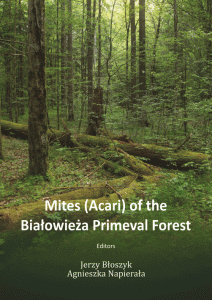Mites (Acari) of the Białowieża Primeval Forest – editors: Jerzy Błoszyk & Agnieszka Napierała
 |
Mites (Acari) of the Białowieża Primeval Forest Pod redakcją: Jerzego Błoszyka & Agnieszki Napierały Wydanie: pierwsze
Rok wydania: 2020
Oprawa: miękka Objętość: 128 stron Format: 170×240 mm Język: angielski
Kategoria: nauki przyrodniczea ISBN 978-83-66476-02-8
MONOGRAFIA NAUKOWA
|
Nie tak dawno w związku z kolejną gradacją kornika drukarza [Ips typographus (Linnaeus, 1758)] atakującego drzewostany świerkowe w Puszczy Białowieskiej toczyła się dyskusja nad sposobami i formami ochrony tego unikatowego w skali Europy kompleksu leśnego. Nikt z przyrodników nie kwestionował wyjątkowości walorów przyrodniczych Puszczy, chociaż zdania na temat czy należy stosować ochronę czynną czy też nie były podzielone. Nie było też jednomyślności w sprawie powiększenia obszaru Puszczy objętego ochroną, a więc wyłączonego z użytkowania gospodarczego.
Not so long ago due to sudden increase in abundance of the European spruce bark beetle [Ips typographus (Linnaeus, 1758)], which attacked spruce tree stands in the Białowieża Primeval Forest, we could observe a heated discussion in the media about the ways in which we could protect this unique forest complex. None of the experts taking part in the discussion threw into question the unique natural value of the forest, though, they had different opinions as to whether the forest should be protected actively or not. They also were not unanimous about the legally protected area of the forest complex and whether it should be enlarged.
Summary:
The research presented in this publication was conducted in the area of the Białowieża Primeval Forest, which is a unique forest complex with one of the last and largest remaining parts of the immense primeval forest in Europe. The aim of the study was to establish the species composition, community structure and habitat preferences of Uropodina (Acari, Mesostigmata) and ptyctimous mites (Acari, Oribatida) in both legally protected and economic areas of the Białowieża Primeval Forest. The analyzed material contained 32 species of Uropodina and 22 species of ptyctimous mites. The results of the research show that protected areas of Białowieża Primeval Forest as well as not protected areas, are important habitat for many species of mites from the studied groups.
Key words:
community structure; habitat preferences; microhabitats; natural forest; protected areas; ptyctimous mites; Uropodina
Acknowledgments:
The authors would like to thank Dr Tomasz Mokrowiecki for translation and linguistic corrections, and Dr Jerzy Kozak for statistical calculations and Zbigniew Adamski for taking SEM images.
Reviever: prof. dr hab. inż. Anna Seniczak, dr hab. inż. Paweł Sienkiewicz



